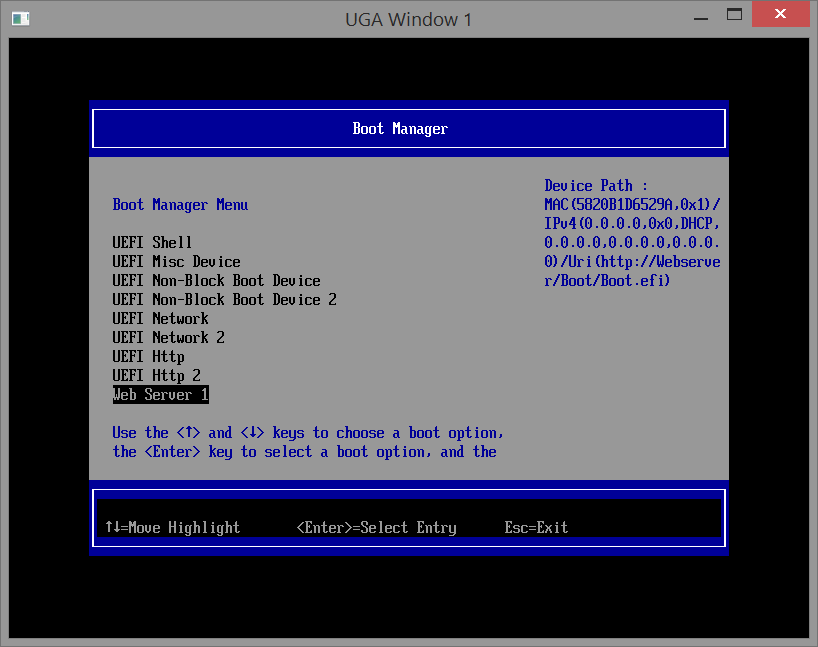-
Notifications
You must be signed in to change notification settings - Fork 344
HTTP Boot
For detailed description on UEFI HTTP Boot, see the "HTTP Boot" section in UEFI Specification.
Please refer to the white paper EDK II HTTP Boot Getting Started Guide for a step by step guide of the HTTP Boot enabling and server configuration in corporate environment.
Besides the standard DHCP parameters like the station IP, gateway and DNS server address, the EDK II HTTP Boot driver will use below extensions assigned by DHCP server in corporate environment.
| Tag Name | Tag # (DHCPv4) | Tag # (DHCPv6) | Length | Data Field |
|---|---|---|---|---|
| Boot File | 'file' field in DHCP header, or option 67 | 59 | Varies | Boot File URI String (eg. "http://Webserver/Boot/Boot.efi" or "http://Webserver/Boot/Boot.iso") |
| Class Identifier | 60 | 16 | 10 | "HTTPClient" |
Unlike the corporate network, in a typical home network only a standard DHCP server is available for host IP configuration assignment, the boot file URI need to be entered by user instead of the DHCP HTTPBoot extensions.

EDK II HTTP Boot driver provides a configuration page for the boot file URI setup.
- In the main page of Boot Manager Menu, enter [Device Manager] -> [Network Device List] -> Select a NIC device -> [HTTP Boot Configuration], set the HTTP boot parameters such as the boot option title, IP start version and the URI address as below.
- Save the configuration and back to the main page, enter [Boot Manager] menu as below, select the new created boot option to start the HTTP Boot.
- To delete the boot option, enter [Boot Maintenance Manager] -> [Boot Options] -> [Delete Boot Option].
Besides the UEFI formatted executable image, the downloaded boot file could also be an archive file (hard disk image) or an ISO image. The file should contain an UEFI-compliant file system and will be mounted as a RAM disk by HTTP Boot driver, to be proceeded in the subsequent boot process.
In EDKII HTTP Boot driver, the image type is identified by the media type, or the filename extensions if "Content-Type" header is not present in the HTTP response message.
| Media Type | Filename Extensions | Image Type | |---| --- | --- | --- | |application/vnd.efi.iso|.iso|Virtual CD Image| |application/vnd.efi.img|.img|Virtual Disk Image| |application/efi|Others (typically *.efi)|UEFI Executable Image|
To enable the HTTP boot and RAM Disk boot support, the RamDiskDxe driver and the UefiBootManagerLib (commit b1bb6f5, commit fb5848c and commit 3a986a3) are also required.
[LibraryClasses]
UefiBootManagerLib|MdeModulePkg/Library/UefiBootManagerLib/UefiBootManagerLib.inf
[Components]
MdeModulePkg/Universal/Disk/RamDiskDxe/RamDiskDxe.inf
Home
Getting Started with EDK II
Build Instructions
EDK II Platforms
EDK II Documents
EDK II Release Planning
Reporting Issues
Reporting Security Issues
Community Information
Inclusive Language
Additional Projects & Tasks
Training
Community Support
Community Virtual Meetings
GHSA GitHub Security Advisories Proceess (Draft)

